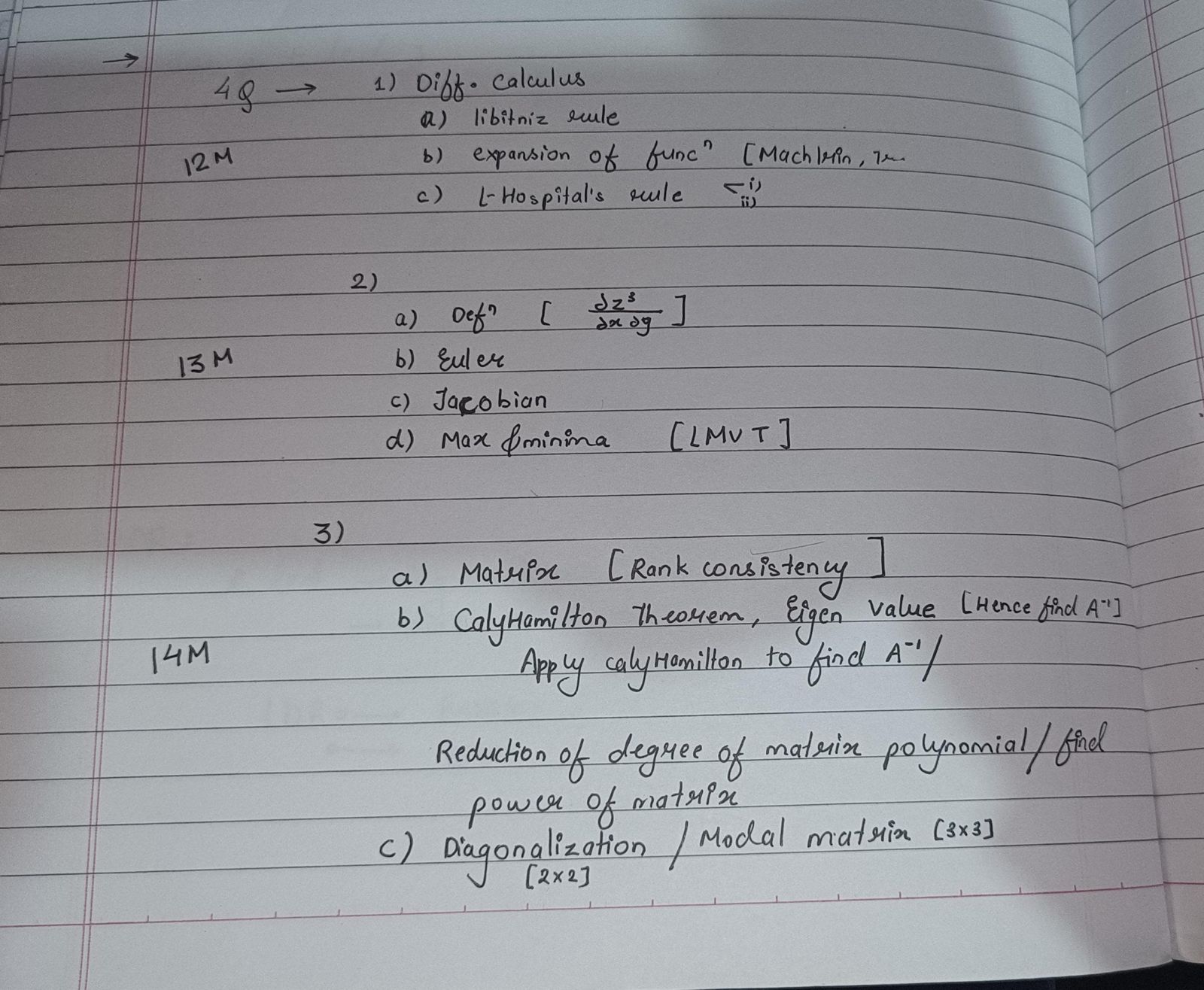1) Differential Calculus: a) Leibniz rule, b) expansion of function (Machin, 12), c) L'Hôpital's rule. 2) a) Definition [ dz^3/dx^2], b) Euler, c) Jacobian, d) Max min. 3) a) Matri... 1) Differential Calculus: a) Leibniz rule, b) expansion of function (Machin, 12), c) L'Hôpital's rule. 2) a) Definition [ dz^3/dx^2], b) Euler, c) Jacobian, d) Max min. 3) a) Matrix [Rank consistency], b) Cayley-Hamilton theorem, Eigen value (hence find A^-1), apply Cayley-Hamilton to find A^-1; Reduction of degree of matrix polynomial/final power of matrix; c) Diagonalization/Modal matrix [3x3; 2x2]

Understand the Problem
The question consists of several problems related to differential calculus and matrix theory, including definitions, expansions, and the application of various theorems. It requires knowledge of mathematical concepts such as L'Hôpital's rule, Jacobians, rank consistency of matrices, and diagonalization.
Answer
1) a) $$ \frac{dF}{dx} = f(g(x)) \cdot g'(x) $$ b) $$ \pi = 16 \tan^{-1}\left(\frac{1}{5}\right) - 4 \tan^{-1}\left(\frac{1}{239}\right) $$ c) $$ \lim_{x \to c} \frac{f(x)}{g(x)} = \lim_{x \to c} \frac{f'(x)}{g'(x)} $$ 2) a) $$ \frac{d^2z^3}{dx^2} = 6z \left(\frac{dz}{dx}\right)^2 + 3z^2 \frac{d^2z}{dx^2} $$ b) $$ e^{ix} = \cos x + i \sin x $$ c) $$ J = \begin{vmatrix} \frac{\partial u}{\partial x} & \frac{\partial u}{\partial y} \\ \frac{\partial v}{\partial x} & \frac{\partial v}{\partial y} \end{vmatrix} $$ d) Max/Min using $f'(x)=0$, $f''(x)>0$. 3) a) Rank consistency. b) $$ p(A) = 0 $$ c) $$ A = PDP^{-1} $$
Answer for screen readers
-
a) Leibniz Rule: $$ \frac{dF}{dx} = f(g(x)) \cdot g'(x) $$
b) Machin's expansion of $\pi$: $$ \pi = 16 \tan^{-1}\left(\frac{1}{5}\right) - 4 \tan^{-1}\left(\frac{1}{239}\right) $$
c) L'Hôpital's Rule: $$ \lim_{x \to c} \frac{f(x)}{g(x)} = \lim_{x \to c} \frac{f'(x)}{g'(x)} $$ -
a) $$ \frac{d^2z^3}{dx^2} = 6z \left(\frac{dz}{dx}\right)^2 + 3z^2 \frac{d^2z}{dx^2} $$
b) Euler's formula: $$ e^{ix} = \cos x + i \sin x $$
c) Jacobian: $$ J = \begin{vmatrix} \frac{\partial u}{\partial x} & \frac{\partial u}{\partial y} \ \frac{\partial v}{\partial x} & \frac{\partial v}{\partial y} \end{vmatrix} $$
d) Max/Min conditions using $f'(x)=0$ and $f''(x)>0$. -
a) Rank consistency checks for solutions of matrices.
b) Cayley-Hamilton theorem: $$ p(A) = 0 $$
c) Diagonalization: $$ A = PDP^{-1} $$
Steps to Solve
-
Leibniz Rule for Differentiation The Leibniz rule provides a method for differentiating an integral. If $F(x) = \int_{a}^{g(x)} f(t) dt$, then: $$ \frac{dF}{dx} = f(g(x)) \cdot g'(x) $$
-
Expansion of Function (Machin's Formula) Machin's formula for $\pi$ states: $$ \pi = 16 \tan^{-1}\left(\frac{1}{5}\right) - 4 \tan^{-1}\left(\frac{1}{239}\right) $$ This can be used to express functions in terms of their Taylor series.
-
L'Hôpital's Rule L'Hôpital's rule assists in evaluating limits of the form $0/0$ or $\infty/\infty$. If $\lim_{x \to c} f(x) = \lim_{x \to c} g(x) = 0$, then: $$ \lim_{x \to c} \frac{f(x)}{g(x)} = \lim_{x \to c} \frac{f'(x)}{g'(x)} $$
-
Definition of $\frac{dz^3}{dx^2}$ This notation implies taking the second derivative of $z^3$ with respect to $x$. First, find the first derivative: $$ \frac{dz^3}{dx} = 3z^2 \frac{dz}{dx} $$ Then, differentiate again to find $\frac{d^2z^3}{dx^2}$.
-
Euler's Formula Euler's formula states: $$ e^{ix} = \cos x + i \sin x $$ This relates exponential functions to trigonometric functions.
-
Jacobian Determinant The Jacobian represents the rate of change of a function with multiple variables. For a function $(u,v)$: $$ J = \begin{vmatrix} \frac{\partial u}{\partial x} & \frac{\partial u}{\partial y} \ \frac{\partial v}{\partial x} & \frac{\partial v}{\partial y} \end{vmatrix} $$
-
Finding Maxima and Minima Use critical points and the second derivative test to assess maxima and minima. If $f'(x) = 0$ at point $x_0$, and $f''(x_0) > 0$, then $x_0$ is a local minimum.
-
Matrix Rank Consistency The rank of a matrix is the dimension of the vector space generated by its rows (or columns). Consistency checks whether a matrix equation has solutions.
-
Cayley-Hamilton Theorem States that every square matrix satisfies its own characteristic polynomial. If $p(\lambda)$ is the characteristic polynomial, then: $$ p(A) = 0 $$
-
Eigenvalues and Finding $A^{-1}$ Determine the eigenvalues from the characteristic polynomial. To find the inverse of $A$, use: $$ A^{-1} = \frac{1}{\text{det}(A)} \text{adj}(A) $$
-
Reduction of Matrix Polynomial Degree If $A$ is a matrix and $p(A)$ is its characteristic polynomial, apply polynomial long division as necessary to reduce the degree.
-
Diagonalization of Matrices A matrix $A$ is diagonalizable if it has enough eigenvectors. For the transformation: $$ A = PDP^{-1} $$ where $D$ is the diagonal matrix of eigenvalues, and $P$ is the matrix of eigenvectors.
-
a) Leibniz Rule: $$ \frac{dF}{dx} = f(g(x)) \cdot g'(x) $$
b) Machin's expansion of $\pi$: $$ \pi = 16 \tan^{-1}\left(\frac{1}{5}\right) - 4 \tan^{-1}\left(\frac{1}{239}\right) $$
c) L'Hôpital's Rule: $$ \lim_{x \to c} \frac{f(x)}{g(x)} = \lim_{x \to c} \frac{f'(x)}{g'(x)} $$ -
a) $$ \frac{d^2z^3}{dx^2} = 6z \left(\frac{dz}{dx}\right)^2 + 3z^2 \frac{d^2z}{dx^2} $$
b) Euler's formula: $$ e^{ix} = \cos x + i \sin x $$
c) Jacobian: $$ J = \begin{vmatrix} \frac{\partial u}{\partial x} & \frac{\partial u}{\partial y} \ \frac{\partial v}{\partial x} & \frac{\partial v}{\partial y} \end{vmatrix} $$
d) Max/Min conditions using $f'(x)=0$ and $f''(x)>0$. -
a) Rank consistency checks for solutions of matrices.
b) Cayley-Hamilton theorem: $$ p(A) = 0 $$
c) Diagonalization: $$ A = PDP^{-1} $$
More Information
The mentioned concepts are critical in advanced mathematics, particularly in fields like physics and engineering, where differential calculus and matrix theory play substantial roles.
Tips
- Confusing the application of L'Hôpital's rule; it only applies to indeterminate forms.
- Misidentifying critical points when determining maxima and minima.
- Forgetting to check the initial conditions when applying the Cayley-Hamilton theorem.
AI-generated content may contain errors. Please verify critical information